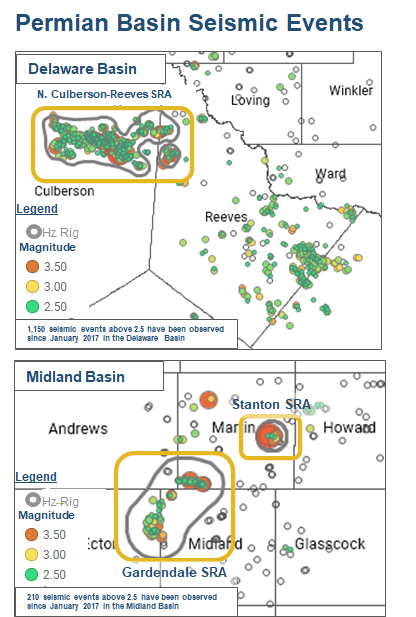If you live in or are a part of the oil and gas business in West Texas you are no-doubt aware of the intensive earthquakes being observed across the Midland and Delaware Basins. Beginning in January 2017, the Texas Bureau of Economic Geology was tasked by the Texas Legislature to monitor earthquakes in Texas, ultimately leading to the TexNet Seismic Monitoring Program (TexNet). In only a few short years since then, TexNet has monitored significant seismic activity throughout the Midland and Delaware basins and recent signs suggest that this activity could pick up in terms of count and intensity.
Intensive earthquakes have recently been observed across the Midland and Delaware Basins:
- Over 1,500 seismic events have been recorded in areas of oil and gas production (~1,300 in the Permian) that are above 2.5 in magnitude
- Seismic activity significantly increased during 2021 in unique count and intensity
The Texas Railroad Commission (RRC) have identified three Seismic Response Areas (SRAs) in the Permian Basin and have determined that saltwater disposal (SWD) injections contribute to the seismic activity:
- The Northern Culberson-Reeves SRA was established in October 2021 after 15 magnitude 4.0 or greater earthquakes were recorded since January 2020;
- The Gardendale SRA was established in September 2021 after six earthquakes of magnitude 3.5 or greater occurred between February 2020 and September 2021; and
- The Stanton SRA was established in January 2022 after nine earthquakes of magnitude 3.0 or greater have occurred since January 2020 including a 4.6 magnitude on December 28, 2021.

What is currently being done to address the issue?
In response to the increase in seismic activity, several state legislatures and commissions are enacting new policies and regulations to limit seismic events. These new policies will have significant implications for upstream operators and midstream water companies. The Texas Railroad Commission is working with the operators and the approach to each SRA has been different:
- Gardendale (first SRA): initially limited injection volumes and stopped deepwater injections for a subset of wells, but more recently stopped all deepwater injections, as the seismic activity did not stop. The RRC has ceased the issuance of SWD permits in the Gardendale SRA.
- North Culberson/Reeves SRA: operators are initially given 90 days to come up with a proposal of next steps, which with progress was extended to 120 days, with February 22 as the next decision date.
- Stanton SRA: industry is being given 90 days to come up with a response plan and the RRC will implement it’s own plan if they are not happy with the industry response.
Stay tuned, West Texas and New Mexico upstream operators and water service companies will be affected by any near and long-term policy response.
For more analysis on the earthquake activity in west Texas, please download our full analysis below.




